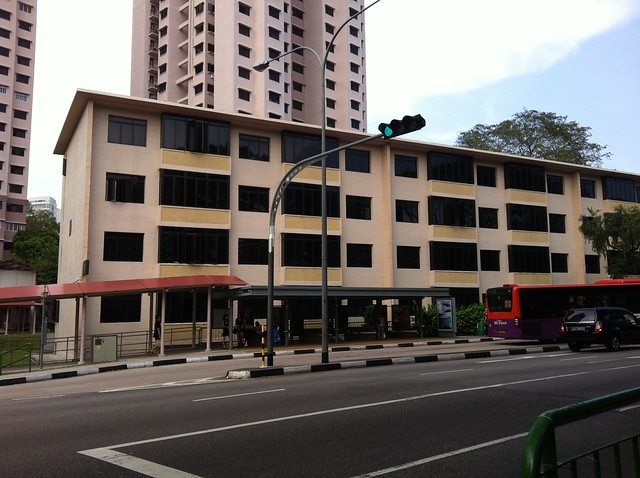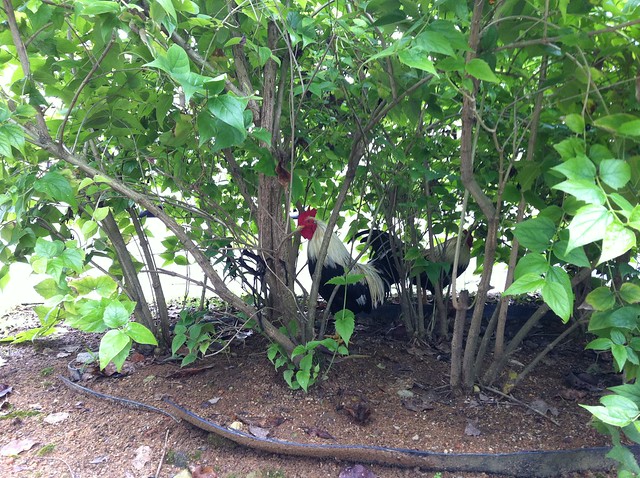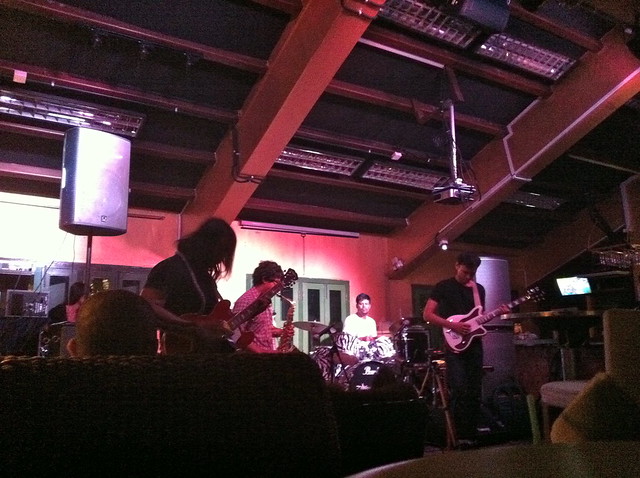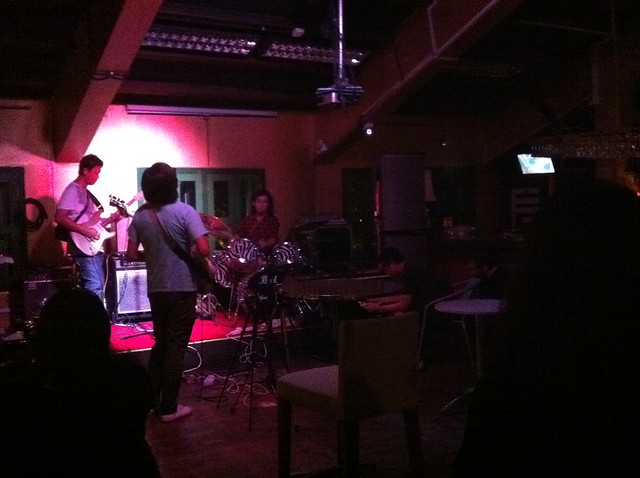A response to the curation of
Occupy Tiong Bahru
and the exhibition
Goddess of Mercy (M1 Fringe Festival)
__________________________________
On Reading and Writing the Story of Tiong Bahru

The story of Tiong Bahru, as it has been presented to us in "High Quality Stories" (Occupy Tiong Bahru's catalog), is a story that is familiar to all. It tells a story of the tensions involved in gentrification and heritage tourism. It is a story about the problematic nature of commodifying this pure and "authentic" history, packaging it into something that can be sold to upwardly-mobile yuppies, young hipster professionals, and how these issues can be dealt with thoughtfulness, self-awareness, and aesthetically interpreted by a group of artists within the neighbourhood itself.
"These are real people, with real lives lived", Alan Oei's blurb to "High Quality Stories" reminds the visitor.
"OH! is part of the gentrification process. But at the very least, let's uncover some of the stories that haven't been told in the race to annoint the place as the hippest neighbourhood in Asia..." Similarly, in her article entitled "Out with the Old", Adeline Chia writes that she despairs of the "cool" factor and the "familiar contradiction" of wanting it to be
"cool enough, but still under the radar" so that other young professionals would not move into Tiong Bahru, causing an increase in the housing prices in the area. At one point, she writes:
"I am a cliche laughing at a cliche."
No doubt that the above statements reveal the intention to display some self-awareness of one's complicity in the situation - something present in many of the pieces in the catalog and in the works - and also serves to explain and excuse oneself from the psychological burden of being part of this gentrification. I appreciate the attempt at candour, but personally I find that it is not an acceptable excuse. Because in the first place, there would be no need for these apologies if one did not participate in the business of turning histories, stories, and cities into commodity.
In his book entitled
"Tristes Tropique", Claude Levi-Strauss wrote the story of his adventures through many "exotic" tropical locales in the course of his career as an anthropologist. The story that Levi-Strauss writes, is a story in which he observes that genuine 'travel' is increasingly being replaced by the motions of tourists moving though what he calls a "
monoculture" - tourists attracted to tours and travel guide books which actually only "preserve the illusion of something that no longer exists". The assertion he makes in his memoir is that today we are faced with the appalling indictment of living in a cultural void, where there is actually no such thing as that nostalgic "vanished reality" and the treasures of history and heritage have actually already been long been plundered from its original site. In other words, "they" become more like "us" and lose their "other-ness" in the process of mutual contact via tourism.
While the original agenda of the Open House tours have been to promote a renewed interest in art and Tiong Bahru's local heritage, it is surely clear to many (yes, you self-aware, ever-so-slightly-hipster individuals) that the transactions involved may not necessarily be fueled by a genuine interest in local cultural traditions, but rather a desire to possess these things and to "live" the lifestyle through this voyeuristic lens into people's homes. Works like Lavender Chang's long exposure nude portraits of the homeowners in their bedrooms are said to be reflecting our voyeurism back at us, but could potentially be read by outside viewers as some kind of exhibitionism or self-indulgence (no offense meant to the homeowners, who so graciously let everyone tramp around their homes for two weekends, but this is simply to state the obvious of what would be the next alternative reading of the work).
What I suspect is that people presume that Tiong Bahru's heritage is somehow valuable (and hence frequently commodified as a designer lifestyle and consequently a hot property/rental zone) because we assume that anything from the past is more "authentic" than whatever is in the present, and that the present is to be seen as something that has lost this element of "authenticity" (and thus devalued). Not surprisingly, visitors and
reviewers of Occupy Tiong Bahru appeared interested to see how the artists' works would respond or react to the hidden histories of the area. Meanwhile this forms the paradox - as the overarcing storyline presented by Occupy Tiong Bahru openly tells the visitor that the artistic reinterpretation and subsequent response to Tiong Bahru via the Occupy Tiong Bahru project is "part of the gentrification process" - in other words, it suggests that the artistic reinterpretation of works in houses in Tiong Bahru is complicit in desacralising that which had once been a "real" and "authentic" Tiong Bahru.
The next paradox that emerges as a result of this is that we would not be able to value or appreciate the concept of the "authentic" without this rampant and flagrant circulation of "fake" copies/approximations of the "original" thing. Yet, we can only confirm the "authentic" as having that "authenticity" only if it has re-entered the market of commodities (and thus becoming available for the consumer to buy it and only then to have to evaluate it for this concept of the "authentic"). Therefore I come to the conclusion that this obsession for the authentic is actually created only when one participates in this business of commodifying histories, stories, and heritage.
The easiest way to stop this madness and escape this paradoxical, never-ending loop of desiring a "vanished reality" would obviously be to stop focusing on the question of "authenticity" and what is "real". This is perhaps where I do not fully agree with the overall direction taken in presenting it as a paradox, from the "tongue-in-cheek" title that, as it turns out, did not really engage with the relevance of the
Occupy movement halfway across the globe, to the very mention of "prestige anxiety"; which can be said to be predicated on one's insecurity of the market valuation of these "relics" of Tiong Bahru.
I find it far more useful and also far more important to stop focusing on the commodification, and instead use this an opportunity to question how we construct authenticity - or even how we can construct multiple authenticities.
We need no reassurances of the quality of these stories, or discussions on quality or authenticity. For me, I reckon that it is more important to show works that inspire and encourage others to write their own stories. There is no need to focus on the missing gaps of the story or the fragmentation of "reality" in the space between past and present - I would rather read it as a sort of call-to-action for Singaporean artists and curators to go and fill it in by themselves!
_______________________
Walking away from the guided tour
As one of the last tours that Saturday night, our group faced a number of logistical problems as many previous groups had been delayed and we were forced to visit the houses in a desultory fashion. We also had to wait over ten minutes outside each flat. Certainly we were there to "occupy" Tiong Bahru's various corridors for unseemingly long periods of time. I am not bothered by having to deviate from the proscribed order of landmarks on a tour, neither do I mind a little waiting, however, a combination of logistical errors also revealed general attitudes amongst people here with regards to how they approach and explore new spaces - and this made me despair.
We had arrived late at the umpteenth flat, so our guide had led us to a clearing outside the house, where we could watch it from what appeared to be a respectful distance. It was clear that the wait would take several minutes as the group before us was not yet done, so I meandered off the pavement into the grass under the trees, and I found a severely chewed-up rat trap, a pear-shaped orange-coloured fruit (that was not an orange), and a moderately thick tree branch that had somehow managed to grow itself into a perfect 90 degree angle, like a pipe with a perpendicular joint.
Even in the most unremarkable terrains, I always like to think that curiosities can still emerge, from the tiniest slivers of clues we can begin the process of building whole narratives. The point of exploration, I think, is to find a way to alter the everyday experience of place into something different every single time. To approach everything as if you had never been there before, even if you have been there a million times, and to force yourself to relinquish the complacency of saying to yourself, "I expect it'll be the same picture and the same story all over again so there's no point looking at what's around me."

Once, on one of these meanders, I even found a rooster in a bush.
After this little meander, I returned to the sight of my tour group still crowded together, standing and waiting helplessly on the pavement. A middle aged woman clutching her handbag walked past the group, observing what must have been an unusual sight of a crowd of people standing on the pavement, facing the entrance of a building some metres away. It simply seemed utterly absurd that everyone was perched atop this concrete pavement between two large, expansive patches of grass. I believe at this point our well-meaning but increasingly flustered tour guide was also trying to reel in the attentions of our group by periodically offering up nuggets of charming but textbook-sounding histories, but by this point it had honestly gone all pear-shaped for me. I was equally exasperated by what looked like a "self-kettling" by the attendees of this Occupy, which was being reinforced by the manner in which the tour was being conducted by our guide. People stood silently waiting their turn before going into the houses briefly to take a few "snaps". This was utterly bewildering to me (and perhaps exacerbated by logistical constraints) - because I thought, weren't we all here because we wanted to explore Tiong Bahru?
I pointed to the strange division between concrete pavement and grass and asked, "Why are you all standing on the pavement! You could walk on the grass or stand on it!"
I've realised that the part of the city that is significant to me is off the map and off the path - and this is probably explains why I am so
interested in cartography. And something that
Iain Sinclair had written in a commentary about the London Olympics also came to mind. Some months ago I had read an interview in which Sinclair mentioned that one of his book covers involved a picture of a pilgrim "stooped under a rucksack, reading as he walks". He had described walking as "a form of reading, in the same way you can read a painting, or landscape." He wrote: "The way to explore London’s territory initially was walking, which involved a burden of other people’s knowledge. So the rucksack represents this unread mass of material. Not just fictions, but testaments, documentation, statistics, obliterated council papers, adverts."
I completely agree with this idea of walking as reading, but I recalled distinctly that I took issue with the fact that within the same article, Sinclair had voiced a belief that the urban writer (who conceived of his prose as inspired by the city and while walking along) was going to die out, only to be replaced by the jumpy image-sampling internet writer - which he also seemed to suggest was inadequate of being able to produce the same kind of complex, textured prose that Sinclair himself had produced in his career as a writer. My gut response to this at the time was that it was inaccurate to say so - because I was of that internet generation, and this hadn't stopped me from walking or looking for those "magical, obscure places". But now I see his point in all this. It is not the internet that he was actually taking issue with, but the very "culture of listing, exposing, producing the guidebook", abetted by the internet and mobile technologies, that is stopping people from walking. Sure, I hadn't stopped walking despite being connected to the internet, but this could not be said of everyone else. The Internet was enabling people to find exactly what they wanted, and in doing so, indirectly preventing them from taking the long route on foot to find what they wanted.
Likewise, the guided tour experience draws a line from point A to point B and in doing so, allows the tourist to skip everything inbetween - when in fact the more important discovery was to be made in the spaces between, this "conjunctive loci" of the ellipsis written into the story . . .
In those seemingly empty spaces between those points lie the most interesting part of the city, waiting for us to find them and fill in the blanks.
_________________________
Goddess of Mercy
Before going to see Occupy Tiong Bahru, we went to see Alecia Neo's installation "Goddess of Mercy" at The Substation. In my view, this was almost a microcosm of Occupy Tiong Bahru - in that it was also bringing audiences into a representation of "rustic" (Bukit Timah) or "shophouse" (Queenstown) living spaces.
To be honest, I believe that which is sacred remains sacred because it is not put on display and remains outside of circulation. It also certainly does not need to made digestable, or to be re-presented in the context of art and set down right in front of the audience. We often talk of this issue of making things or viewpoints "accessible to an audience" - especially in the context of Singaporeans' level of art appreciation" - but I do not think we need to simplify anything at all at this point if Singapore is to develop into a nation of people who are able to think for themselves.
Part of "Goddess of Mercy" featured Dr Nalla and her son Tan Ying Hsien, whose house was also the site of Alecia and Clarence Chung's previous exhibition, where they "restaged" the family's own photographs in their own home before it was going to be demolished.

There is a video of Dr Nalla Tan being pushed in her wheelchair - showing her in a state of deterioration from Alzheimer's where she has become nothing but a pale, uncommunicative shadow of her former self. The very fact that she is no longer able to speak as Dr Nalla Tan worries me because it is her life being "restaged" as art without her ability to give her consent. Many younger audiences will be unfamiliar with Dr Nalla Tan's former role as a feminist, her being one of the first to talk about sex education in Singapore, and being one of the first females to become a doctor in Southeast Asia. These were roles and parts she had actively played in her life without expecting an audience. So why bring the audience in to see this now? I can only say that I did not understand the motivations behind this entire nostalgia trip.
The re-staging of the living spaces within the gallery as if they were a "shrine" to the memory of the living, while the living (Dr Nalla Tan) are actually still alive but unable to agree or disagree or comment on it, is simply problematic to me.
Again, bringing people directly from point A to point B - such as in the case of recreating two spaces in the same gallery in order to "equip" the audience with "visual library" with which to explore the question of faith, health and disappointment is to me a facetious suggestion at best. I find it to be a visual library of commodified symbols, not so different from the Peranakan-themed restaurant next door satisfying people's desire to purchase heritage and authenticity in their lives in a situation where things are increasingly less real.
Again, this is akin to a "guided tour experience" which has already drawn a line from point A to point B - or in this case, brought point A and point B and recreated them in this gallery, allowing visitors to become lazy by skipping that the crucial journey required in trying to understand these things.
I feel that it is important especially for art about spaces and memory to encourage people to make the journey and the walk on their own if we are to move on from the constant state of paradoxes into a more productive phase of identity-making for Singapore.
Singapore and Singaporean art needs to have more critical engagement of the issue of how and what we choose to we define as "historic" or "memorable", and who gets to define these things. Who will write our stories in the years to come? And who are the stories written for? I would love to see more curators and artists pushing themselves harder to deal with these issues, because I feel that is the only way to really move forward and take control of the present.
____________________________
As this entire blog is written in the spirit of promoting criticality, discussions and comments would be more than welcome.
Additional Note #1: This response is predominantly regarding the overall presentation of the works rather than the specifics of any of the individual artists and their works shown at Open House; it should be obvious to anyone who attended Occupy Tiong Bahru that the context and location overwhelmed most of the artwork placed within the houses itself so it seemed more logical to write about that first - I will try to write about individual works in a separate entry.





